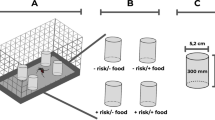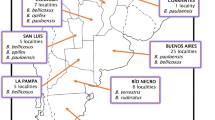Abstract
Ectoparasites have often been shown to have detrimental effects on their host. Not much is known, however, about determinants of infestation, e.g. the question of which factors affect distribution and occurrence of parasites on different host species (degree of host specificity) and their infestation rates. In this study we examine possible effects of host determinants on parasite intensity of Carnus hemapterus (Carnidae), an ectoparasitic fly on nestling birds, in the European bee-eater (Merops apiaster), which is a common host of C. hemapterus. Our results show that European bee-eaters seem to be one of the most heavily infested host species of C. hemapterus. We found that brood size, nestling age, and colony size are the most important determinants of infestation by C. hemapterus. This parasite seems to prefer medium-sized bee-eater chicks and to select them according to their condition. Our results further suggest a negative effect of C. hemapterus on chick development.





Similar content being viewed by others
References
Avilés JM, Pérez-Contreras T, Navarro C, Soler JJ (2009) Male spotless starlings adjust feeding effort based on egg spots revealing ectoparasite load. Anim Behav 78:993–999. doi:https://doi.org/10.1016/j.anbehav.2009.07.020
Bequaert J (1942) Carnus hemapterus Nitzsch, an ectoparasitic fly of birds, new to America (Diptera). Bull Brooklyn Entomol Soc 37:140–149
Cannings RJ (1986) Carnus hemapterus (Diptera: Carnidae), an avian nest parasite new to British Columbia, Canada. Entomol Soc Br Columbia 83:38
Capelle KJ, Whitworth TL (1973) The distribution and avian hosts of Carnus hemapterus (Diptera: Milichiidae) in North America. J Med Entomol 10:525–526
Clayton DH, Moore J (1997) Host-parasite evolution: general principles and avian models. Oxford University Press, Oxford
Clayton DH, Tompkins DM (1995) Comparative effects of mites and lice on the reproductive success of rock doves (Columba livia). Parasitology 110(Pt 2):195–206
Collin JE (1939) On various new or little known British Diptera, including several species bred from the nest of birds and mammals. Ent Mon Mag 75:134–154
Dawson RD, Bortolotti GR (1997) Ecology of parasitism of nestling American kestrels by Carnus hemapterus (Diptera: Carnidae). Can J Zool 75:2021–2026
De Lope F, Møller AP (1993) Effects of ectoparasites on reproduction of their swallow host: a cost of being multi-brooded. Oikos 67:557–562
Fargallo JA, Blanco G, Potti J, Vinuela J (2001) Nestbox provisioning in a rural population of Eurasian Kestrels: breeding performance, nest predation and parasitism. Bird Study 48:236–244
Figuerola J (2000) Ecological correlates of feather mite prevalence in passerines. J Avian Biol 31:489–494
Glutz von Blotzheim UN, Bauer KM (1980) Handbuch der Vögel Mitteleuropas. Akademische Verlagsgesellschaft, Wiesbaden
Grimaldi DA (1997) The bird flies, genus Carnus: species revision, generic relationships, and a fossil Meoneura in amber (Diptera, Carnidae). Am Mus Nov 3190:1–30
Guiguen C, Launay H, Beaucournu J-C (1983) Ectoparasites des oiseaux en Bretagne. I: Répartition et écologie d’un diptère hématophage nouveau pour la France: Carnus hemapterus Nitzsch (Cyclorrhapha, Carnidae). Rev Fr Entomol 5:54–62
Hennig W (1937) Milichiidae et Carnidae. In: Lindner E (ed) Die Fliegen der paläarktischen Region. Schweizerbart’sche Verlagsbuchhandlung, Stuttgart
Hoi H, Darolová A, König C, Krištofík J (1998) The relation between colony size, breeding density and ectoparasite loads of adult European bee-eaters (Merops apiaster). Ecoscience 5:156–163
Hoi H, Hoi C, Krištofík J, Darolová A (2002) Reproductive success decreases with colony size in the European bee-eater. Ethology Ecol Evol 14:99–110
Janovy JJ (1997) Protozoa, helminths and arthropods of birds. In: Clayton DH, Moore J (eds) Host-parasite evolution: general principles & avian models. Oxford University Press, Oxford, pp 303–337
Kirkpatrick CE, Colvin BA (1989) Ectoparasitic Fly Camus hemapterus (Diptera: Carnidae) in a Nesting Population of Common Barn-Owls (Strigiformes: Tytonidae). J Med Entomol 26:109–112
Kleinbaum DG, Kupper LL (1978) Applied regression analysis and other multivariable methods. Duxbury Press, North Scituate, Mass
Krištofík J, Masan P, Sustek Z (1996) Ectoparasites of bee-eaters (Merops apiaster) and arthropods in its nests. Biologia (Bratislava) 44:557–570
Lehmann T (1993) Ectoparasites: direct impact on the host fitness. Parasitology Today 9:8–13
Liker A, Markus M, Vozar A, Zemankovics E, Rozsa L (2001) Distribution of Carnus hemapterus in a starling colony. Can J Zool 79:574–580
Lloyd GD, Philip CB (1966) The wingless fly, Carnus hemapterus Nitzsch (Milichiidae), on hawk fledglings in Northern Utah. J Parasitol 52:414
Marshall AG (1981) The ecology of ectoparasitic insects. Academic Press, New York, London
Matyukhin A, Krivosheina M (2008) Contribution to the knowledge of Diptera (Insecta) parasitizing on birds. Entomol Rev 88:258–259. doi:https://doi.org/10.1134/S0013873808020115
Møller AP (1993) Ectoparasites increase the cost of reproduction in their host. J Anim Ecol 62:309–322
Møller AP (1997) Parasitism and the evolution of the host life history. In: Clayton DH, Moore J (eds) Host-parasite evolution: general principles & avian models. Oxford University Press, Oxford, pp 105–127
Poiani A (1993) Small clutch sizes as a possible adaptation against ectoparasitism: a comparative analysis. Oikos 68:455–462
Roulin A, Riols C, Dijkstra C, Ducrest AL (2001) Female plumage spottiness signals parasite resistance in the barn owl (Tyto alba). Behav Ecol 12:103–110
Svensson L (1993) Identification guide to European non-passerines. The British Trust for Ornithology, Stockholm
Valera F, Casas-Criville A, Hoi H (2003) Interspecific parasite exchange in a mixed colony of birds. J Parasitol 89:245–250. doi:https://doi.org/10.1645/0022-3395(2003)089[0245:IPEIAM]2.0.CO;2
Valera F, Hoi H, Darolova A, Krištofík J (2004) Size versus health as a cue for host choice: a test of the tasty chick hypothesis. Parasitology 129:59–68. doi:https://doi.org/10.1017/S0031182004005232
Walter G, Hudde H (1987) Die Gefiederfliege Carnus hemapterus (Milichiidae, Diptera), ein Ektoparasit der Nestlinge. J Ornithol 128:251–255
Wiebe KL (2009) Nest excavation does not reduce harmful effects of ectoparasitism: an experiment with a woodpecker, the northern flicker Colaptes auratus. J Avian Biol 40:166–172. doi:https://doi.org/10.1111/j.1600-048X.2009.04481.x
Wright SP (1992) Adjusted P-values for simultaneous inference. Biometrics 48:1005–1013
Acknowledgments
We thank R. Hengsberger and R. Wagner for comments on earlier drafts and F. Valera and M. Romero-Pujante for assistance in the field. The study was supported by VEGA project (No. 2/0089/08).
Author information
Authors and Affiliations
Corresponding author
Additional information
Communicated by F. Bairlein.
Rights and permissions
About this article
Cite this article
Hoi, H., Krištofík, J., Darolová, A. et al. Are parasite intensity and related costs of the milichiid fly Carnus hemapterus related to host sociality?. J Ornithol 151, 907–913 (2010). https://doi.org/10.1007/s10336-010-0529-5
Received:
Revised:
Accepted:
Published:
Issue Date:
DOI: https://doi.org/10.1007/s10336-010-0529-5




